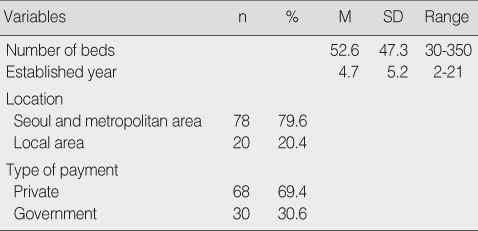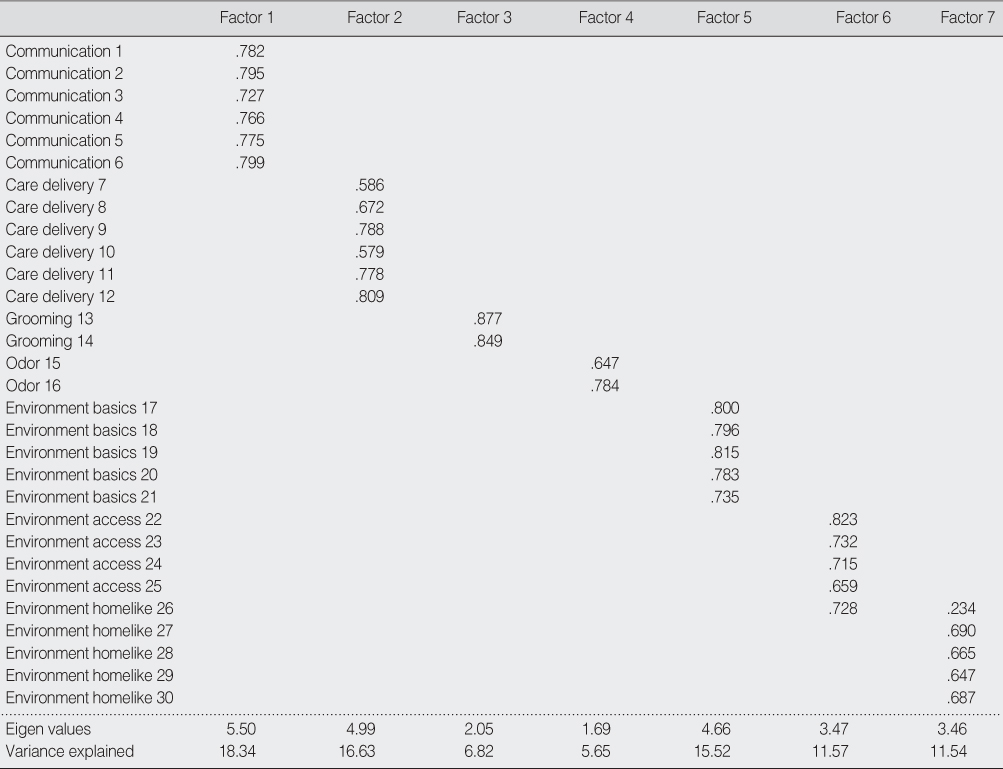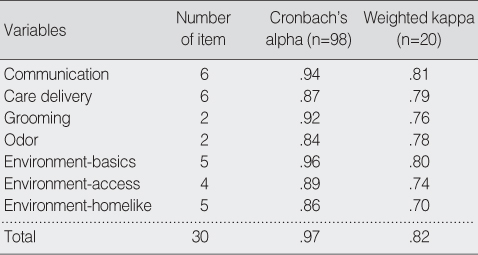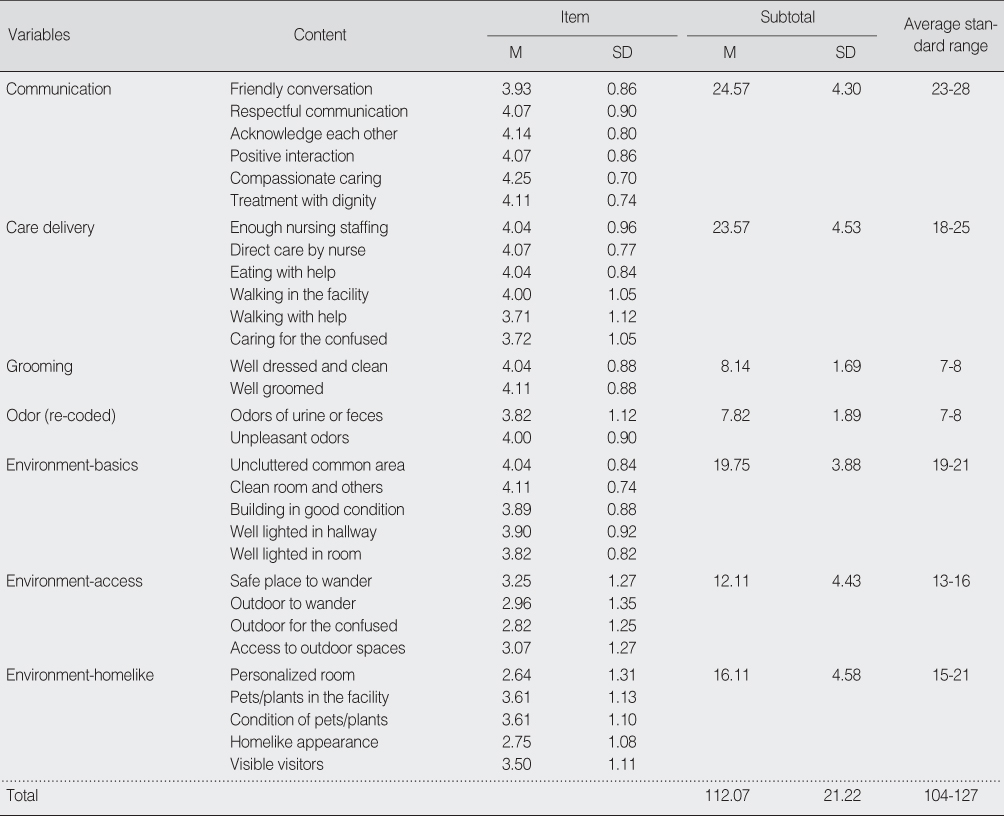Articles
- Page Path
- HOME > J Korean Acad Nurs > Volume 38(3); 2008 > Article
-
Original Article
- Validity and Reliability of the Korean Version of the Observable Indicators of Nursing Home Care Quality Evaluation Instrument
- Jia Lee
-
Journal of Korean Academy of Nursing 2008;38(3):474-482.
DOI: https://doi.org/10.4040/jkan.2008.38.3.474
Published online: June 30, 2008
Assistant Professor, College of Nursing Science, Kyung Hee University, Seoul, Korea.
- Address reprint requests to: Lee, Jia. College of Nursing Science, Kyung Hee University, 1 Hoegi-dong, Dongdaemun-gu, Seoul 130-701, Korea. Tel: 82-2-961-0894, Fax: 82-2-961-9398, leejia@khu.ac.kr
• Received: May 6, 2008 • Accepted: May 28, 2008
Copyright © 2008 Korean Society of Nursing Science
Abstract
-
Purpose
- The purposes of this study were; 1) to test the validity and reliability of the Korean version of Rantz's Observable Indicators of Nursing Home Care Quality Instrument (ONHQ) and 2) to evaluate the quality of Korean nursing homes.
-
Methods
- The study employed a three-phase methodological research design. 1) The original instrument of Rantz's ONHQ was translated into Korean and modified by Korean nursing home experts. 2) A pilot study using the modified instrument was done in 20 nursing homes to examine inter-rater reliability. 3) The validity and reliability were tested in 98 nursing homes.
-
Results
- Seven factors were extracted through factor analysis: 'communication', 'care delivery', 'grooming', 'odor', 'environment-basics', 'environment-access', and 'environment-homelike'. These factors explained 86.07% of the total variance. Cronbach's alpha coefficient of the 30 items was .97 indicating a high internal consistency of the instrument. Inter-rater reliability according to Kappa was .82. The average score of nursing home quality was 112.07 indicating an average range of quality level.
-
Conclusion
- The Korean version of the ONHQ was identified as a tool with a high degree of validity and reliability. This tool can be effectively used to assess the quality of nursing homes by professions as well as family members.
This work was supported by the Korea Research Foundation Grant funded by the Korean Government (MOEHRI), Basic Research Promotion Fund (KRF-2007-331-E00289).
- 1. Arling G, Kane RL, Lewis T, Mueller C. Future development of nursing home quality indicators. The Gerontologist. 2005;45:147–156.ArticlePubMed
- 2. Aud MA, Lee J. Introducing nursing students to quality assurance activities in skilled nursing facilities. Journal of Nursing Care Quality. 2006;21:121–123.ArticlePubMed
- 3. Bryant FB, Yarnold PR. Grimm LG, Yarnold PR. Principal components analysis and exploratory and confirmatory factor analysis. In: Reading and understanding multivariate statistics. 1995;Washington, D. C, American Psychological Association.
- 4. Chung J. Development and application of nursing service quality indicators in nursing homes. Journal of Korean Academy of Nursing. 2007;37:401–413.ArticlePubMedPDF
- 5. Fleiss JL. Statistical methods for rates and proportions. 1981;2nd ed.New York, Wiley.
- 6. Gordon M. Nursing diagnosis. Process and application. 1994;3rd ed.Missouri, Mosby.
- 7. Han GJ. A study on the interior design of the elderly care facilities. Korean Journal of Design Science Research. 2003;6(2):21–31.
- 8. Hong SW, Son HM. Family caregivers' experiences utilizing a nursing home for their elderly family members. Journal of Korean Academy of Nursing. 2007;37:724–735.ArticlePubMedPDF
- 9. Hwang SC. Evaluation of Korean nursing home quality. Korean Social Science Research. 2001;6:66–84.
- 10. Kim KA. Development of an evaluation tool for the quality of nursing care in elderly facility. 2005;Seoul, Chung-Ang University. Unpublished doctoral dissertation.
- 11. Kim SJ. The effect of reminiscence therapy on recognition, response of emotion, communication ability of elderly patient with Alzheimer's dementia. 2006;Daegu, Daegu University. Unpublished master's thesis.
- 12. Kim OS, Kim SS, Kim KO, Kim YA, Kim HS, Park JS, et al. A study of needs of private nursing home for elderly parents. Journal of Korea Gerontological Nursing Society. 2005;7:20–27.
- 13. Korea Ministry of Health and Welfare. National survey of living status and welfare needs of the elderly. 2007;Seoul, Ministry of Health and Welfare.
- 14. Korea Ministry of Health and Welfare. National status of elder care facilities 2008. 2008;Seoul, Ministry of Health and Welfare.
- 15. Nunnally JC, Bernstein I. Psychometric theory. 1994;3rd ed.New York, McGraw-Hill Humanities.
- 16. Park TR. Criteria of evaluations of the rest homes and nursing homes. Korean Journal of Social Science Research. 1999;7:61–86.
- 17. Rantz M, Jensdóttir AB, Hjaltadóttir I, Gudmundsdóttir H, Sigurveig Gudjónsdóttir J, Brunton B, et al. International field test results of the observable indicators of nursing home care quality instrument. International Nursing Review. 2002;49:234–242.ArticlePubMed
- 18. Rantz MJ, Zwygart-Stauffacher M. A new reliable tool for nurse administrators, nursing staff, regulators, consumers, and researchers for measuring quality of care in nursing homes. Nursing Administration Quarterly. 2006;30:178–181.Article
- 19. Rantz MJ, Zwygart-Stauffacher M, Mehr DR, Petroski GF, Owen SV, Madsen RW, et al. Field testing, refinement, and psychometric evaluation of a new measure of nursing home care quality. Journal of Nursing Measurement. 2006;14:129–148.ArticlePubMed
- 20. Shim MJ. A study on the augmentation of private welfare facilities for the aged. 2000;Seoul, Dan Kook University. Unpublished master's thesis.
- 21. Song JA, Lim YM, Hong GS. Wandering behavior in Korean elders with dementia residing in nursing homes. Journal of Korean Academy of Nursing. 2008;38:29–38.ArticlePubMed
REFERENCES
Figure & Data
REFERENCES
Citations
Citations to this article as recorded by 

- Relationship between environmental factors and responsive behaviours in long-term care homes: a secondary data analysis
Kelsey Holt, Matthias Hoben, Lori Weeks, Carole Estabrooks
BMJ Open.2021; 11(10): e047364. CrossRef - Factors influencing the adaptation to skilled nursing facilities among older Korean adults
Jin Yi Choi, Sohyune R Sok
International Journal of Nursing Practice.2015; 21(2): 184. CrossRef - Factors Associated Quality of Life of Elderly in Non-paid or Paid Assisted Living Facilities
So-Hyune R. Sok, Jin-Yi Choi
Korean Journal of Adult Nursing.2012; 24(2): 99. CrossRef - Development of an Evaluation Instrument for Service Quality in Nursing Homes
Jia Lee, Eun Sun Ji
Journal of Korean Academy of Nursing.2011; 41(4): 510. CrossRef - Structural Factors Influencing the Quality Management Activities in Nursing Homes
Tae Wha Lee, Jane Chung
Journal of Korean Academy of Nursing Administration.2010; 16(2): 162. CrossRef - Predictors of Facility Adaptation in Nursing Home Residents
Hyekyung Lee, Hyang-Yeon Lee, Jia Lee
Journal of Korean Academy of Nursing.2009; 39(2): 177. CrossRef
- We recommend
- Related articles
-
- Reliability and validity of the Korean version of the Nurses Professional Values Scale-3 for nursing students: a methodological study
- Validity and Reliability of the Korean Version of the Occupational Coping Self-Efficacy Scale for Nurses
- The Reliability and Validity of the Korean Version of the 5C Psychological Antecedents of Vaccination Scale
Validity and Reliability of the Korean Version of the Observable Indicators of Nursing Home Care Quality Evaluation Instrument
Validity and Reliability of the Korean Version of the Observable Indicators of Nursing Home Care Quality Evaluation Instrument
General Characteristics of Nursing Homes (N=98)
Factor Loading of Each Item (N=98)
Reliability Tests of Internal Consistency and Equivalence
Evaluation of Nursing Home Quality by the Korean Version of the Observable Indicators of Nursing Home Care Quality Instrument (N=98)
Table 1
General Characteristics of Nursing Homes (N=98)
Table 2
Factor Loading of Each Item (N=98)
Table 3
Reliability Tests of Internal Consistency and Equivalence
Table 4
Evaluation of Nursing Home Quality by the Korean Version of the Observable Indicators of Nursing Home Care Quality Instrument (N=98)
 KSNS
KSNS
 E-SUBMISSION
E-SUBMISSION




 Cite
Cite

